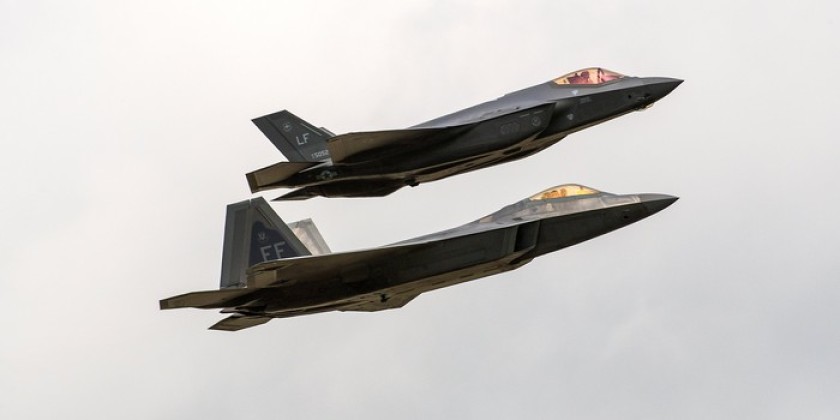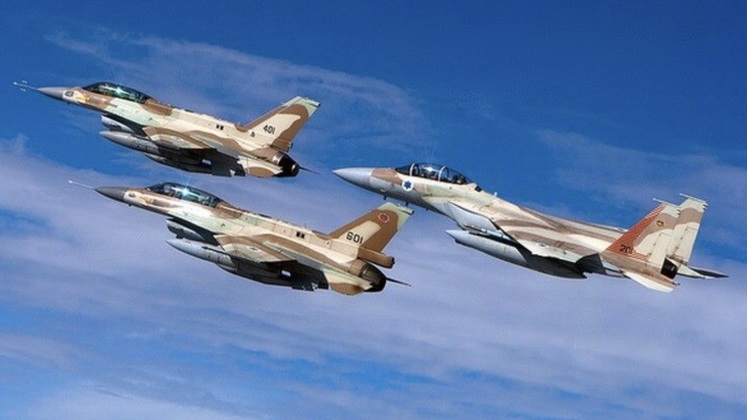Leading Israeli media outlet Haaretz has reported that the country has
requested permission to purchase F-22 Raptor fifth generation fighter jets from the United States. This request was made on the basis that should the U.S. sell F-35A fighter jets to neighbouring Arab states - namely the United Arab Emirates and which have both sought to purchase the fighter - the F-22 would be the only Western fighter capable of guaranteeing an Israeli advantage in the air. The request is highly unusual for a number of reasons - most significantly because the Barak Obama administration terminated production of the F-22 in 2009 meaning that if the Israeli request is serious, it wants to buy aircraft second hand from the United States Air Force which were produced over a decade ago. Secondly, the U.S. Congress notably imposed a ban on the export of the F-22 while it was in production, which prevented Japan and Israel, the two most interested parties, from placing orders. Israel’s ability to afford the F-22, which has by far the
The F-22 and F-35 are the only two Western fifth generation fighters ever to become operational, with the latter in serial production today and being offered widely to U.S. defence clients for export. The F-22 is a more expensive heavyweight twin engine aircraft which is faster, has a longer range, carries more weapons and a heavier radars and has a far superior flight performance with unrivalled manoeuvrability among American aircraft. Its radar cross section is also lower, making it more difficult to detect at longer ranges. The F-35 by contrast was designed to be cheaper both to manufacture and to operate, was intended for export, and is not specialised for air to air combat but instead is capable of performing in all combat roles. It can only carry half as many air to air missiles as the F-22 can without compromising its stealth, although it is better suited to air to ground missions and can carry nuclear weapons and high diameter bombs. The two aircraft are respective successors of the F-15 and F-16 of the Cold War era - which were designed with similar purposes in mind to their respective successors. Unlike the F-22, however, the older F-15 was not banned from export entirely, but was reserved for export to a select few close partners - namely Israel, Japan and Saudi Arabia. The U.S. decision to refuse Israel and Japan the F-22, the natural successor for their Cold War era heavyweight jets, was this seen as a major blow to both countries’ aerial warfare capabilities

F-35 (top) and F-22 Stealth Fighters
The U.S. decision not to sell Israel the F-22 was heavily influenced by the Middle Eastern state’s close defence partnerships with and sale of sensitive technologies to both China and Russia - raising the prospect that F-22 technologies could become compromised in Israeli hands. The end of the Cold War was another influencing factor, and meant that neighbouring Syria had lost Soviet support and access to its high end aircraft which eliminated a prospective threat to the F-15’s superiority - meaning there was no urgent need to supply F-22s. As of 2020 however, the U.S. could well be inclined to sell its most capable fighter to Israel. While Syria’s air force presents only a minor challenge to Israel, its neighbours Iran and Egypt both have access to very advanced Russian fighters with the latter having already ordered Su-35 heavyweight jets. According to several reports by American analysts, the Su-35’s air to air combat capabilities are superior to those of rival western jets with the exception of the F-22. More seriously still, Iran is considered a leading client for Russia’s Su-57 jet, which could give it a serious advantage over the much lighter Israeli F-15s and F-35s - presuming Iran can train pilots to a comparable standard to their Israeli counterparts.

Israeli F-16s Leading Heavyweight F-15
Alongside the emergence of new regional challenges in the air, which could incline the U.S. to provide Israel with Raptors, the benefit of removing Israeli opposition to the sale of F-35 jets to the gulf states could make a Raptor sale worthwhile for America. Such sales have the potential to bring tens of billions of dollars in revenue, particularly if parties beyond the UAE and Qatar such as Saudi Arabia show an interest in purchasing the single engine stealth fighters. Arming these states with advanced stealth fighters would also reduce the burden on the U.S. to defend them - placing further military pressure on Iran while allowing the U.S. to focus more on other regions such a northeast Asia. The F-22’s technologies are also considered a lot less sensitive today than they were 15 years ago, with the U.S. having already test flown a prototype of a sixth generation fighter which will likely begin to replace the Raptor around 2030. This provides a further incentive to sell some F-22s on to Israel, particularly as many Raptors in the U.S. Air Force are currently not even combat coded and are used exclusively for training purposes. Ultimately while the Israeli request is highly irregular, it is not unthinkable that the U.S. could consider selling F-22s to its closest Middle Eastern defence partner despite having refused it in the past, with both parties potentially benefitting significantly from such a sale.

 militarywatchmagazine.com
militarywatchmagazine.com
requested permission to purchase F-22 Raptor fifth generation fighter jets from the United States. This request was made on the basis that should the U.S. sell F-35A fighter jets to neighbouring Arab states - namely the United Arab Emirates and which have both sought to purchase the fighter - the F-22 would be the only Western fighter capable of guaranteeing an Israeli advantage in the air. The request is highly unusual for a number of reasons - most significantly because the Barak Obama administration terminated production of the F-22 in 2009 meaning that if the Israeli request is serious, it wants to buy aircraft second hand from the United States Air Force which were produced over a decade ago. Secondly, the U.S. Congress notably imposed a ban on the export of the F-22 while it was in production, which prevented Japan and Israel, the two most interested parties, from placing orders. Israel’s ability to afford the F-22, which has by far the
The F-22 and F-35 are the only two Western fifth generation fighters ever to become operational, with the latter in serial production today and being offered widely to U.S. defence clients for export. The F-22 is a more expensive heavyweight twin engine aircraft which is faster, has a longer range, carries more weapons and a heavier radars and has a far superior flight performance with unrivalled manoeuvrability among American aircraft. Its radar cross section is also lower, making it more difficult to detect at longer ranges. The F-35 by contrast was designed to be cheaper both to manufacture and to operate, was intended for export, and is not specialised for air to air combat but instead is capable of performing in all combat roles. It can only carry half as many air to air missiles as the F-22 can without compromising its stealth, although it is better suited to air to ground missions and can carry nuclear weapons and high diameter bombs. The two aircraft are respective successors of the F-15 and F-16 of the Cold War era - which were designed with similar purposes in mind to their respective successors. Unlike the F-22, however, the older F-15 was not banned from export entirely, but was reserved for export to a select few close partners - namely Israel, Japan and Saudi Arabia. The U.S. decision to refuse Israel and Japan the F-22, the natural successor for their Cold War era heavyweight jets, was this seen as a major blow to both countries’ aerial warfare capabilities

F-35 (top) and F-22 Stealth Fighters
The U.S. decision not to sell Israel the F-22 was heavily influenced by the Middle Eastern state’s close defence partnerships with and sale of sensitive technologies to both China and Russia - raising the prospect that F-22 technologies could become compromised in Israeli hands. The end of the Cold War was another influencing factor, and meant that neighbouring Syria had lost Soviet support and access to its high end aircraft which eliminated a prospective threat to the F-15’s superiority - meaning there was no urgent need to supply F-22s. As of 2020 however, the U.S. could well be inclined to sell its most capable fighter to Israel. While Syria’s air force presents only a minor challenge to Israel, its neighbours Iran and Egypt both have access to very advanced Russian fighters with the latter having already ordered Su-35 heavyweight jets. According to several reports by American analysts, the Su-35’s air to air combat capabilities are superior to those of rival western jets with the exception of the F-22. More seriously still, Iran is considered a leading client for Russia’s Su-57 jet, which could give it a serious advantage over the much lighter Israeli F-15s and F-35s - presuming Iran can train pilots to a comparable standard to their Israeli counterparts.

Israeli F-16s Leading Heavyweight F-15
Alongside the emergence of new regional challenges in the air, which could incline the U.S. to provide Israel with Raptors, the benefit of removing Israeli opposition to the sale of F-35 jets to the gulf states could make a Raptor sale worthwhile for America. Such sales have the potential to bring tens of billions of dollars in revenue, particularly if parties beyond the UAE and Qatar such as Saudi Arabia show an interest in purchasing the single engine stealth fighters. Arming these states with advanced stealth fighters would also reduce the burden on the U.S. to defend them - placing further military pressure on Iran while allowing the U.S. to focus more on other regions such a northeast Asia. The F-22’s technologies are also considered a lot less sensitive today than they were 15 years ago, with the U.S. having already test flown a prototype of a sixth generation fighter which will likely begin to replace the Raptor around 2030. This provides a further incentive to sell some F-22s on to Israel, particularly as many Raptors in the U.S. Air Force are currently not even combat coded and are used exclusively for training purposes. Ultimately while the Israeli request is highly irregular, it is not unthinkable that the U.S. could consider selling F-22s to its closest Middle Eastern defence partner despite having refused it in the past, with both parties potentially benefitting significantly from such a sale.

Israel Just Asked the U.S. For Elite F-22 Raptor Fighter Jets - Could It Ever Happen?
Leading Israeli media outlet Haaretz has reported that the country has requested permission to purchase F-22 Raptor fifth generation fighter jets from the United States.
